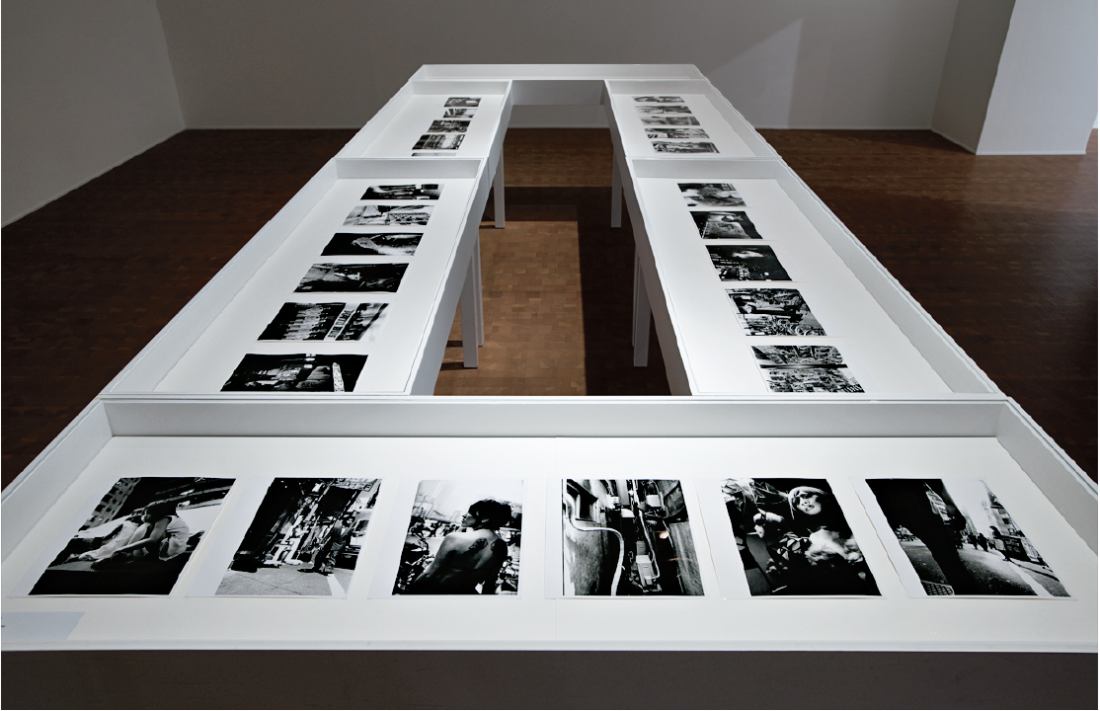Daido Moriyama
“When I go out into the city I have no plan…I walk down one street, and when I am drawn to turn the corner into another, I do…I am like a dog: I decide where to go by the smell of things, and when I am tired, I stop,” wrote Daido Moriyama.
It’s a dog’s life using instinct as your navigational tool: it’s quietly thrilling to wander a city with no agenda beyond finding what presents itself, and in my experience, the hyper-kinetic bustle of Japan’s big city streets promises endless photo ops and anonymity as a reliable cloak. Daido Moriyama has been crawling the streets of Shinjuku, American army bases and far-flung locales such as Argentina and Hawaii with a compact camera in tow for close to four decades. Starting as a graphic artist and moving into freelance photography, he has produced arresting, iconic black-and-white images that are now equally at home on gallery walls, in print and on expensive t-shirts and bags.
“On the Road” surveys a prolific career built on discarding photography’s formalistic and technical strictures via 12 key photobooks, from early pulpy half-toned photostats to glossy, rich volumes published by fashion house Hysteric Glamour. This is an exhaustive—and at times exhausting—tour of the world through Moriyama’s lens: noirish, askew and predatory, with blown-out contrast and an emphasis on grain so thick it appears tactile like a cat’s tongue.
The confrontational nature of the ’60s is present in the work of Moriyama, who was part of the radical Provoke magazine in Japan clique and who counts titans like Shōmei Tōmatsu and the notorious Nobuyoshi Araki as friends and contemporaries. The disorienting, wilful transgression of the era’s avant-garde cinema and the alienation in Japanese fiction reverberates, recalling Mishima, the sexually frank verité of Toshio Matsumoto’s film Funeral Parade of Roses, and Kenzaburō Oe’s A Personal Matter, one of the few novels I had to abandon because it was just too damn greasy and miserable, Nobel Prize for Literature status notwithstanding.

Daido Moriyama, installation view of “On the Road,” 2011. © Daido Moriyama. Photograph: Kazuo Fukunaga. Courtesy the National Museum of Art, Osaka.
It’s not a sunny show: blind children, blurry in flagrante forms in love hotels, the desolate back streets and garish neon of seedy neighbourhoods and their inhabitants recall Arbus and Weegee, but are graphically attuned in terms of how the images “pop.” Sex and existential nausea often entwine: intimacy seems rented and desperate, while the bulk of his work picks at urban loneliness, most apparent in the iconic Stray Dog, 1971. Here, a mutt glances at the lens, its expression bouncing between pathos, defensive glare and blank menace. It’s a powerful, revealing shot; in his essay “Investigations of a Dog” (Art in America, 1999), Leo Rubinfein examines how Moriyama’s work highlights the status of the renegade in a society where the nail that sticks out—as the old saying goes—usually gets hammered down. For my money, Moriyama is to Japan what Robert Frank is to the Americans.
There are a few problems, however. His trademark vibe of voyeuristic alienation hangs so heavy and sinister that even his still lifes resemble crime scenes, and the overwhelming parade of stark imagery becomes an unsettling maze. Curatorially, “On the Road” suffers from its own thoroughness—there’s so much work, most of it good, that the impact flattens out. This makes the dross really stick out: a suite of colour pieces from the 1970s is wobbly at best, showing a dedicated black-and-white photographer trying his hand at colour, while the “Light and Shadow” era feels uncertain, not unlike darkroom prints by photo students just discovering the wonders of push processing. This is the kind of exhibit that warrants another visit (or buying the catalogue) so you can search beyond the iconic pieces that came with the price of admission—the dog, the bit lip, the fishnets, the leering stage actor caked in drag—in order to take in the breadth of his work.
That said, the most impressive part of the show is a large room with a floor-to-ceiling tiled grid of new, large works in colour. Resembling film stills from an imaginary sequel to Chris Marker’s Sans Soleil, Moriyama’s latest are graceful while retaining the furtive look and speed of point-and-shoot photography. His shifty, gestural approach is measured and aware of fashion and style: a screen grab of Andy Warhol and a cluster of street posters of Lady Gaga shot by Terry Richardson make an appearance, while his old pal and occasional collaborator Araki makes a cameo appearance backgrounded, naturally, by a crush of love hotels (perhaps his cheery, pervy irreverence helped Daido lighten up a little). In colour, the school girls, salarymen, male escorts, gyaru and other fashion victims of Tokyo’s street life appear comical, making his earlier prickly nihilism seem affected, almost too comfortable in exposing raw nerve. Angry young men become angry old men, or refined lest they complacently run on impotent rage and we see the work of a man no longer at war with his craft. ❚
“Daido Moriyama: On the Road” was exhibited at the National Museum of Art, Osaka, Japan, from June 28 to September 19, 2011.
Christopher Olson is a graduate of Emily Carr University in Vancouver and now calls Nara, Japan, home.

